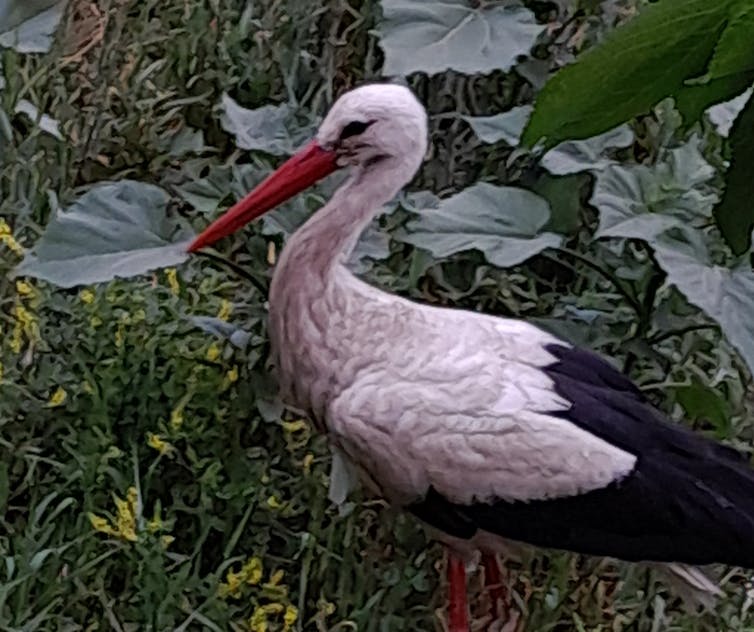The 2025 Tribeca Movie Competition in New York included a world premiere of Struggle By way of the Eyes of Animals (often known as Animals in Struggle). The documentary offers an animal-eye view of Russia’s warfare towards Ukraine and options the wartime experiences of a number of totally different species, together with a cow, a rabbit and a wolf.
All through historical past, animals have been affected by warfare and uncovered to its many risks. Regardless of this, warfare is normally mentioned from human-centred views that marginalise animal experiences.
My very own work on the Russia-Ukraine warfare makes use of sound as a mind-set about a few of the warfare’s environmental impacts and the experiences of animals. The concept that sound can present ecological data will not be new. Analysis has proven how the sounds, for instance, of vegetation and animals can inform us rather a lot about how their surroundings is altering. What’s new is exploring this within the context of warfare.
For my analysis mission I interviewed greater than 30 Ukrainians, together with botanists, ornithologists, herpetologists (who research reptiles and amphibians) and a marine biologist. I additionally requested them to make brief recordings of their native soundscapes.
A scientist working in Tuzlivski Lymany Nationwide Park within the Odesa area of southern Ukraine made a recording of Iranian Shahed drones flying over his workplace and defined that these “irregular” sounds significantly have an effect on some species of birds.
Interviewee recording879 KB (obtain)
In 2024, for instance, there was a big colony of nesting flamingos in Tuzlivski Lymany. Nonetheless, noise triggered them to desert their nests, leaving their eggs susceptible to predators. No chicks had been born within the flamingo colony that 12 months. Analysis in peacetime has discovered that drones can result in vital breeding failures amongst some birds.
A herpetologist, in the meantime, shared his recording of natterjack toads and European tree frogs that he made within the Volyn area of northern Ukraine the 12 months earlier than the beginning of the full-scale invasion in 2022.
What he wished to convey was that he could by no means hear this specific “amphibian refrain” once more. The realm is near the border with Belarus, and it’s unclear what influence the development of Ukrainian defensive fortifications has had on native animal and vegetation.
I additionally requested interviewees whether or not the warfare has helped nature in any manner. In response, they incessantly talked about diminished anthropogenic (human-made) pressures on the surroundings. An instance is the ban on looking, first imposed at first of the warfare in jap Ukraine in 2014.
One interviewee recorded a nighttime summer season meadow in Kyiv area and captured the distant sound of a fox calling. The prohibition on looking has enabled foxes to thrive
One other interviewee made a recording close to the Kaniv Nature Reserve in central Ukraine. Alongside birdsong are the barking sounds of roe deer, one other species that has benefited from the looking ban.
After all, such inhabitants will increase are usually not essentially helpful to wider ecosystems, as ecologist Aldo Leopold mentioned in his traditional Pondering like a Mountain (1949). Leopold discovered that uncontrolled numbers of deer as a result of mass killing of wolves in the USA throughout the first a part of the twentieth century took an enormous toll on the surroundings. “I’ve seen each edible bush and seedling browsed”, he wrote”, “first to anaemic desuetude, after which to demise”.
The truth that the Russia-Ukraine warfare has contributed to decreasing some anthropogenic pressures doesn’t in any manner minimise the enormity of hurt performed to nature, together with forests, soil and marine ecosystems. But it’s too slim to consider the surroundings solely by way of harms performed to it.
Nature’s restoration
The Chernobyl Exclusion Zone (CEZ) created following the Chernobyl nuclear catastrophe in 1986 is usually cited for example of nature’s capability to get better. One of many ornithologists whom I interviewed made a recording of birdsong from inside the CEZ, in northern Ukraine.
Once I take heed to the recording I’m reminded of analysis which has discovered that birds have tailored physiologically to radiation publicity inside the CEZ.
PA/Roman Pilipey
One other instance of restoration pertains to the destruction of the Kakhovka dam in June 2023. When Russian aggressors breached the dam, water drained from the Kakhovka reservoir, leaving it dry. In the present day, there’s a younger willow forest rising on the positioning of the previous reservoir.
To emphasize the resilience of nature, certainly one of my interviewees made an audio recording from the Yelanets Steppe Nature Reserve within the Mykolaiv area in southern Ukraine. In opposition to the acoustic backdrop of wind gusting by the grasslands are the repeated calls of the frequent pheasant.
These sounds of the wild steppe awakening in early spring, the interviewee confused, are additionally the sounds of nature getting on with life.
Birdsong is clearly audible in a recording made by troopers close to the frontline in Kharkiv area.
Made by Ukrainian troopers801 KB (obtain)
Equally, birds continued to sing over the trenches throughout the first world warfare. Some interviewees additionally identified that sure species of birds, together with cormorants, herons and white storks, have tailored to the sounds of warfare, turning into much less delicate to them.

Picture taken by an interviewee in Ukraine.
Justice and reparations
I’m significantly within the significance of nature’s sounds within the context of transitional justice – and particularly reparations.
Discourse on environmental reparations focuses on repairing harms performed to nature – and sounds can present helpful insights into a few of these harms.
However what’s lacking from current scholarship on reparations is consideration to a few of the ways in which ecosystems can and do regenerate and get better. Transferring ahead, subsequently, it’s important to consider how reparations can assist (and never disturb) these pure ecosystem processes.

















![Call for Papers: International Conference on Environment and Sustainable Development at Gauhati University in Collaboration with UNDP [Sept 18-19; Hybrid]: Submit by Aug 4](https://i2.wp.com/cdn.lawctopus.com/wp-content/uploads/2025/07/International-Conference-on-Environment-and-Sustainable-Development-at-Gauhati-University-in-Collaboration-with-UNDP.jpg?w=120&resize=120,86&ssl=1)




